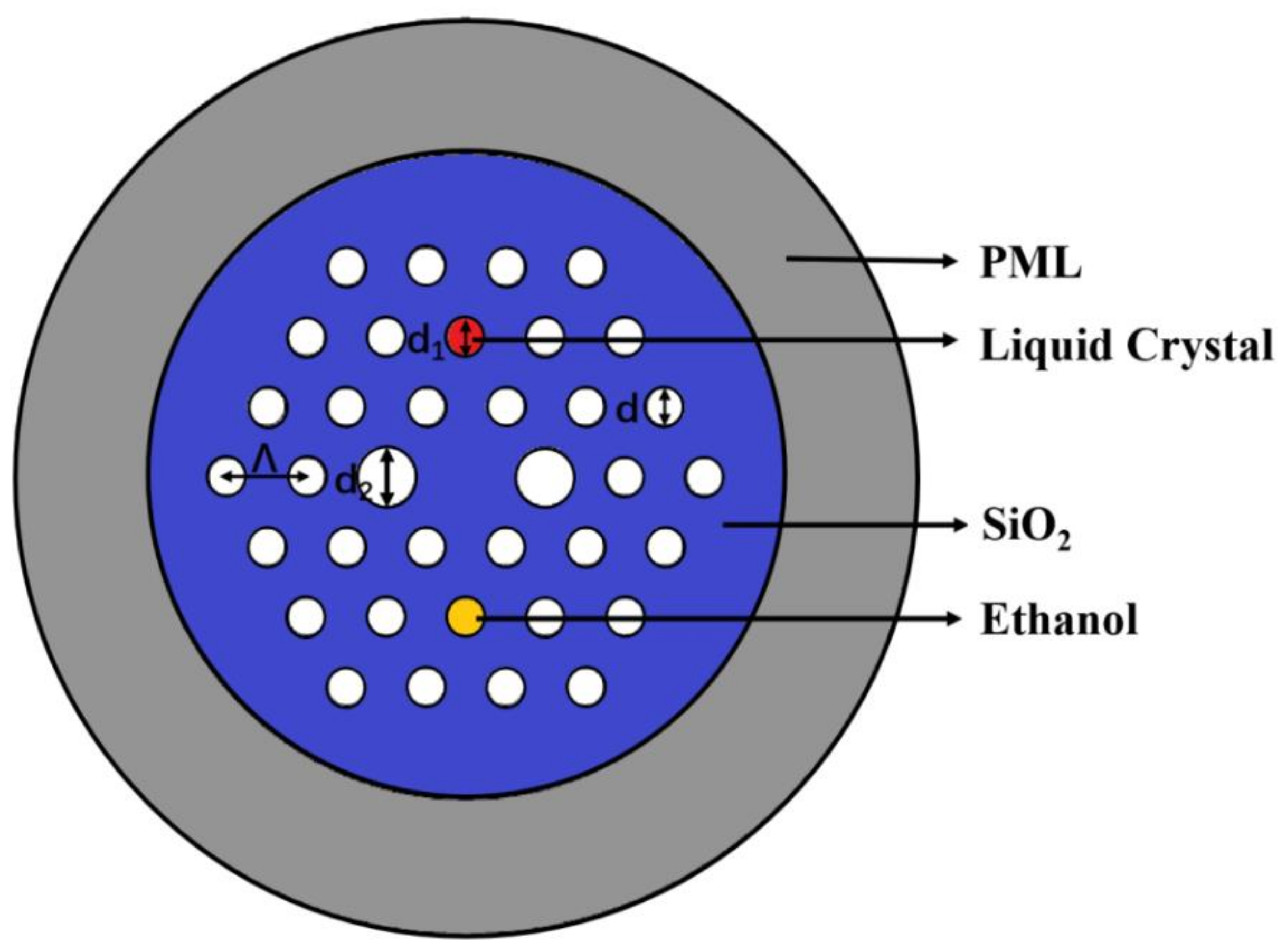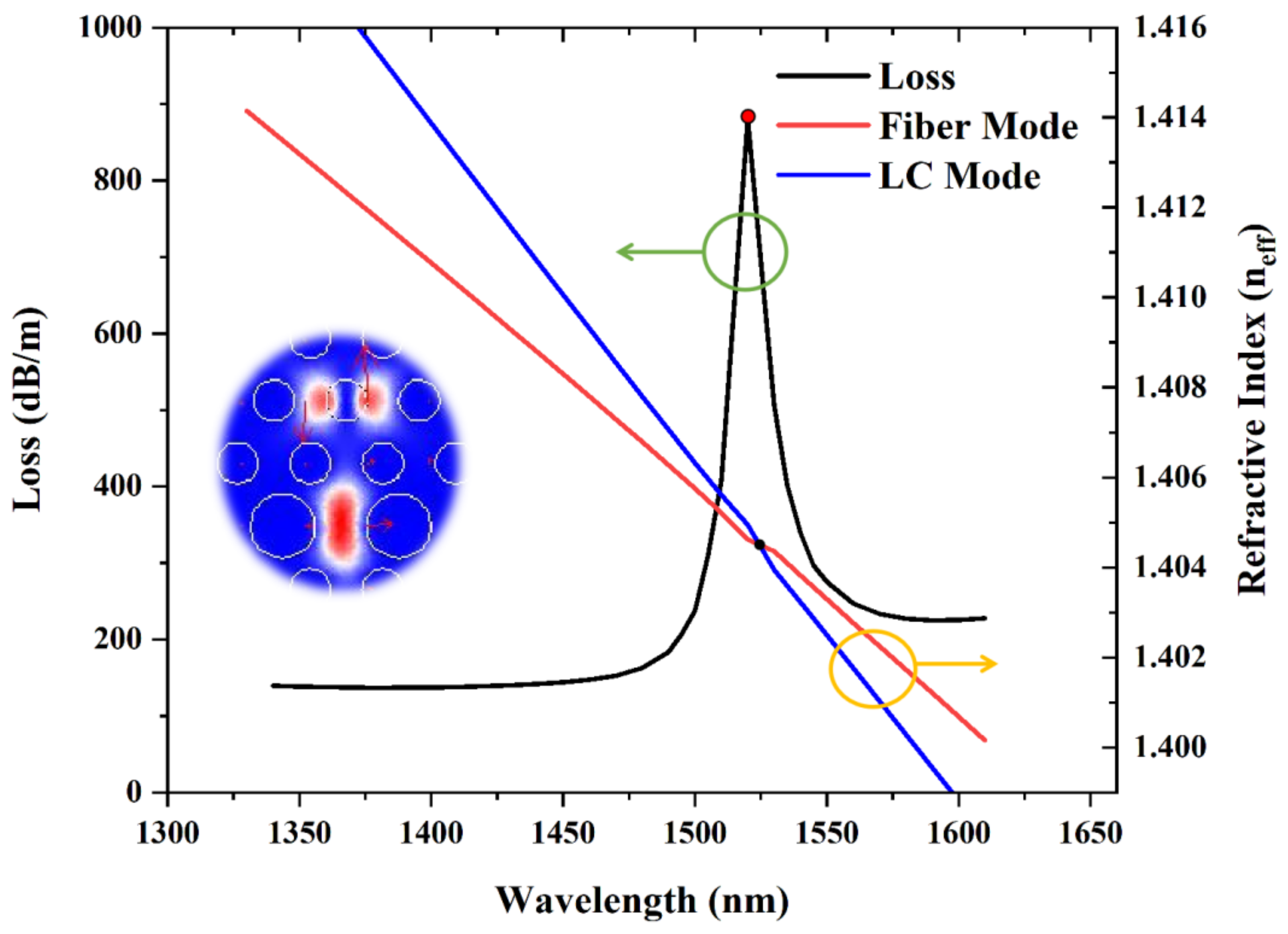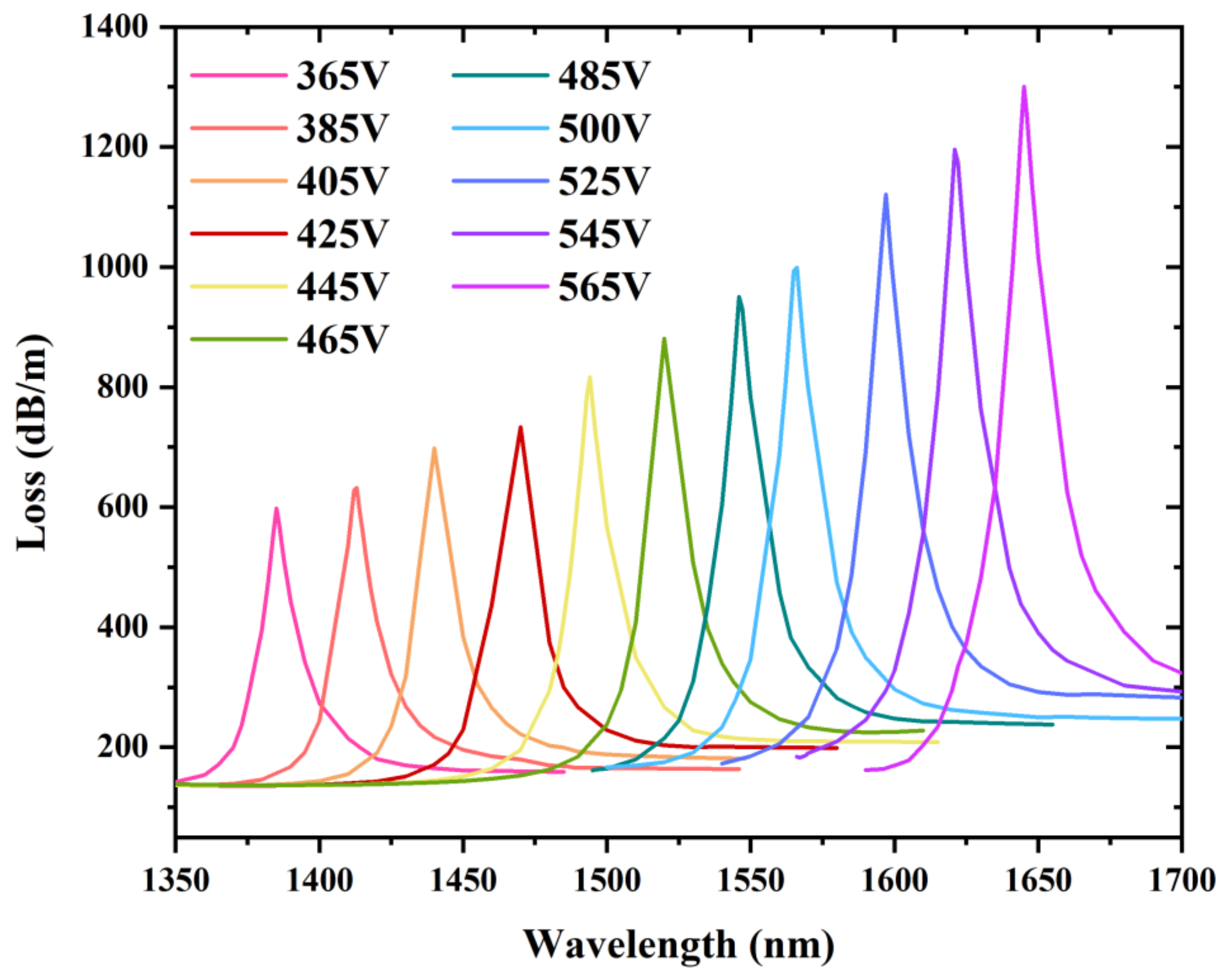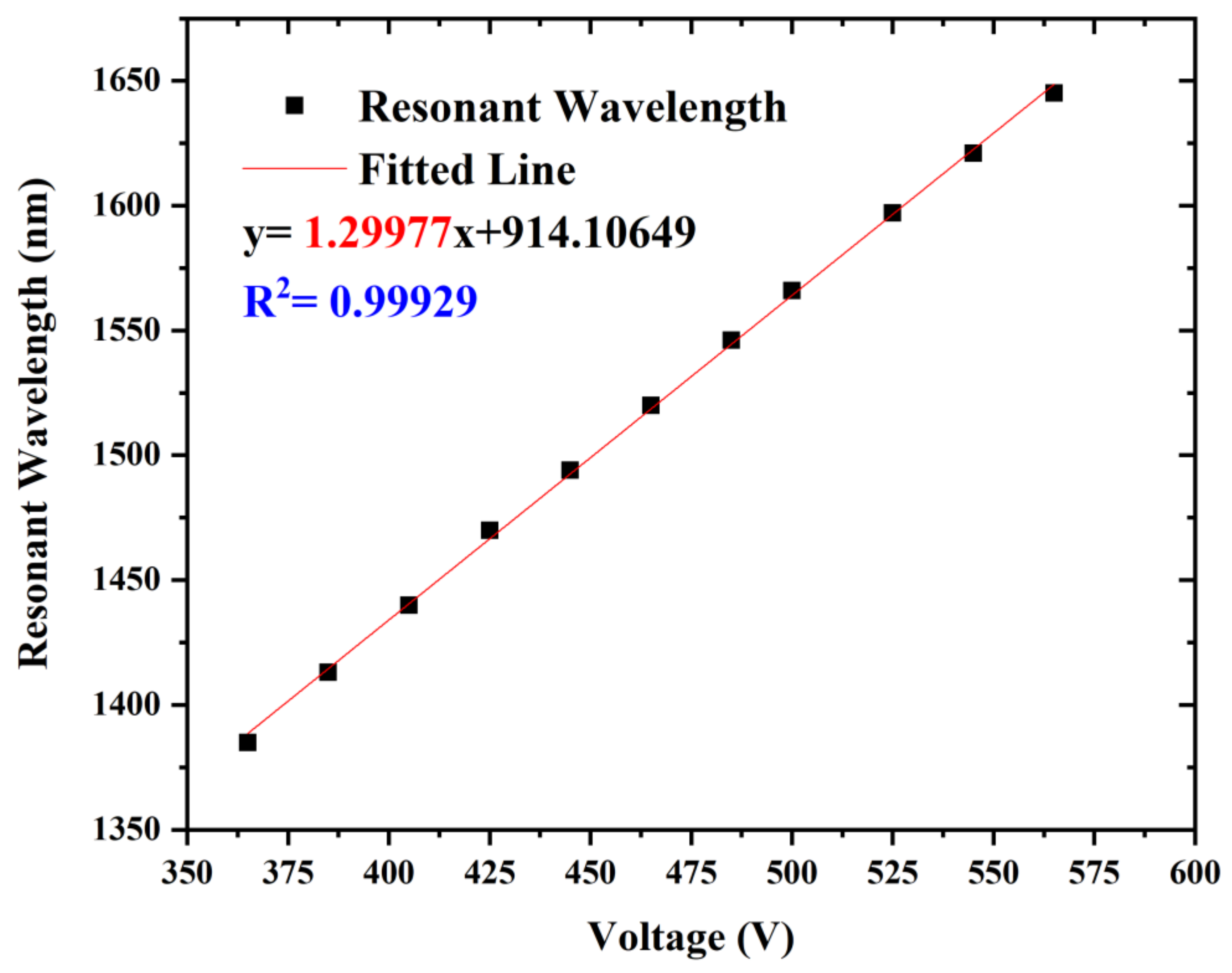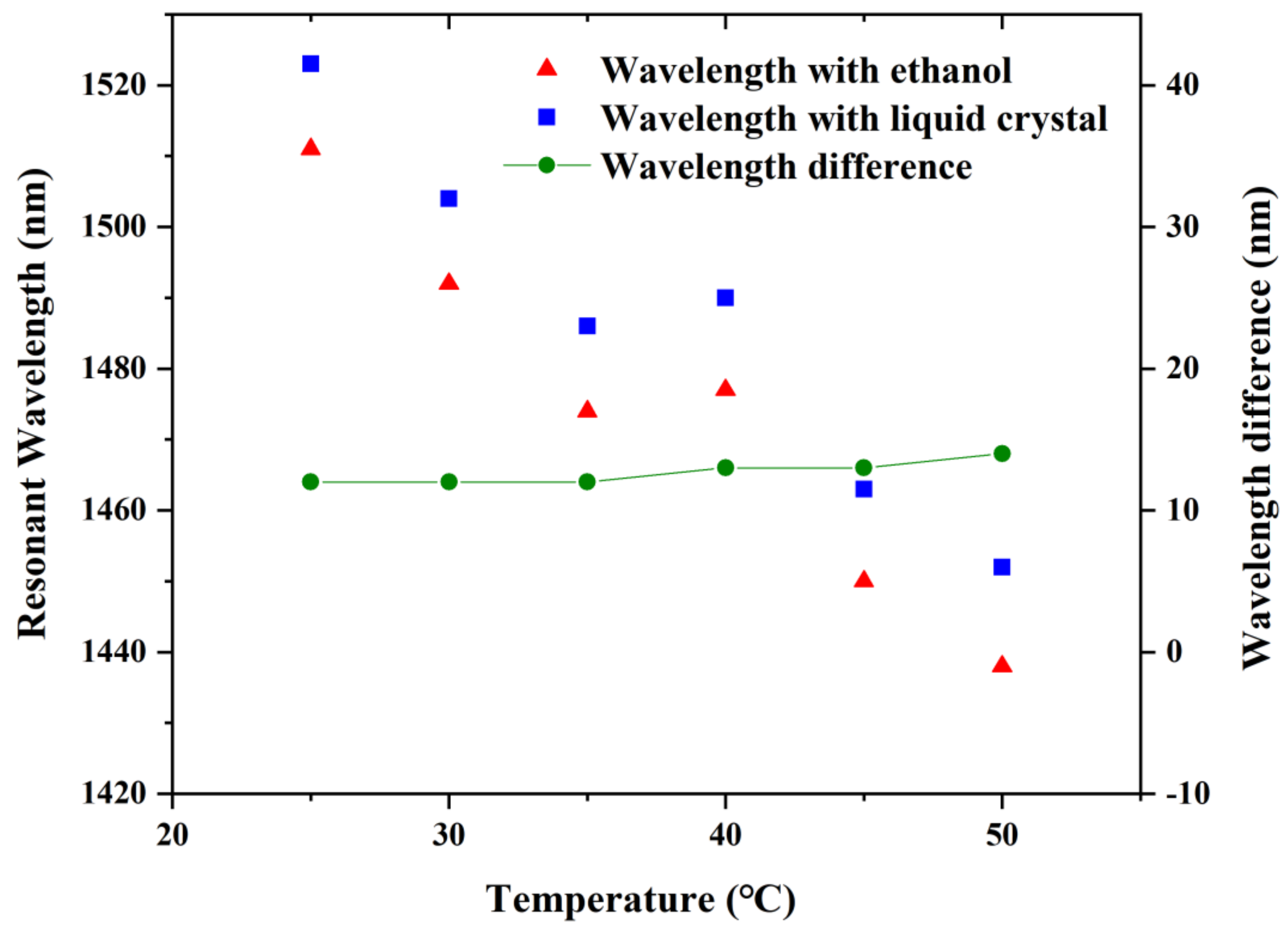1. Introduction
In this high-speed information age, more sensors with fast transmission, large capacity, high electromagnetic interference resistance, and compact size are needed. Due to these strengths, the optical fiber sensing technology has rapidly developed, bringing more opportunities for optical communication, optical sensing, and many other fields. In the last 20 years, a novel type of optic fiber named photonic crystal fiber (PCF) has been emerging rapidly which is generally made up of just one medium. The microstructure cladding of PCFs is lined with a periodic series of wavelength-scaled air holes that are densely packed in the two-dimensional direction while maintaining the same axial structure [
1]. Compared with other conventional optical fibers, the diversity in the structure design of the PCFs is particularly abundant [
2]. As the substrate materials are not environmentally sensitive, the different environmentally sensitive materials are filled into these air holes to create sensors with high sensitivity.
In 1954, J.R. Pierce first proposed the concept of mode coupling in the electromagnetic field during the discussion of the application of traveling wave tubes [
3]. Later in the 1970s, A.W. Snyder [
4], D. Marcuse [
5], and A.Yariv [
6] introduced the mode-coupling theory into the optical waveguide. Ever since, the mode-coupling theory has been widely used in the optical waveguide to make optical devices, such as waveguide directional couplers [
7,
8,
9], fiber optic couplers [
10], distributed feedback lasers [
11], and so on. The mode coupling effect in optical fibers produces a peculiar optical phenomenon and presents excellent optical properties. In recent years, special optical fibers based on the mode coupling effect show unique advantages in confinement loss, dispersion, and nonlinearity, and have been extensively adopted for a large collection of application areas in optical fiber communication and optoelectronic systems. Particularly, mode coupling theory gradually gains attention in fiber sensors. Filling sensitive materials into PCF brings diverse structures, in which another mode is exhibited and the coupling resonance with the fiber mode occurs when waveguide phase matches.
Liquid crystal (LC), as a material sensitive to temperature, electric field, and magnetic field, has been gradually applied in photonic crystal fiber sensors. In addition, LC has birefringent optical properties like crystal [
12], which makes great contributions to the sensor sensitivity. Larsen and Bjarklev et al. from the Danish Institute of Technology were the first to fill liquid crystal into photonic crystal fibers to make fiber sensors. Through controlling the temperature and electric field, they proposed the concept of optical switch [
13]. In 2009, Lei Wei developed an LC-filled PBG-PCF using negative permittivity, which could realize electronic and temperature control tuning. At the voltage value of 200 Vrms, the control temperature range was 20–80 °C and the bandgap change was 396 nm [
14]. In 2015, Hu and Fu et al. put forward an all-fiber Mach–Zehnder interferometer on the basis of liquid crystal filling. They filled the core of a hollow PCF with LC and welded single-mode optical fibers on both ends of the filled PBG-PCF to make a Mach–Zehnder interferometer, reaching a temperature sensitivity of up to −1.55 nm/°C [
15]. It can be seen that the LC-filled PCFs could expand the application function of such fibers. In this paper, LC is infiltrated into one hole of the PCF to realize the voltage sensor by the coupling between the LC mode and fiber mode.
Voltage sensors are widely applied in power distribution systems, cables, electric machinery, and so on. In order to develop voltage sensors with high performances, research on the electro-optic effect [
16,
17,
18], electro-strictive effect [
19,
20,
21], and so on, are generally studied. Fiber voltage sensors have been widely put into application in various sensing sectors due to numerous distinctive qualities, including small weight, rapid reaction, and capability of remote operation. As the voltage surpasses the threshold, the LC molecules inside the air holes spin towards the presence of an electric field. Plenty of studies have been devoted to development of electric optical fiber devices filled with nematic liquid crystal (NLC). Haakestad et al. filled liquid crystal into a refractive-index-directed PCF to obtain a bandgap-guided fiber with a millisecond electrical reaction time [
22]. Ertman et al. injected LC into a high-index PCF, enabling them to alter the phase birefringence adjustment at 0~2 × 10
−4 [
23]. Du et al. developed an electrically tunable filter in which the LC was loaded into PCF in a Sagnac loop with a tuning range of roughly 26 nm, reaching a sensitivity of 0.53 nm/V [
24]. Huang et al. developed an electro-optical modulation established on the resonance principle, using LC injected into a PCF. The modulation range is between 1414 and around 1700 nm, reaching a sensitivity of 5.594 nm/V [
25]. Our research group has undertaken some research on the electrical sensing characteristics based on PCF infiltrated with LC [
26,
27,
28]. However, the temperature stability and reliability are not studied adequately, and the measurement range is not wide enough. Therefore, the voltage sensors based on PCF filled with LC are worth pursuing and in urgent need of development.
In this paper, the finite element method (FEM) based on the COMSOL Multiphysics software is applied to analyze the sensing performances of the PCF infiltrated with functional materials. The fiber mode and LC mode couple with each other as the phase matches. As we change the voltage of ambient environment, ranging from 365 to 565 V, the confinement loss and the resonance wavelength change simultaneously by which voltage can be detected. However, the characteristics of LC would be affected by temperature which would interference with sensor performance. Therefore, ethanol, which is merely sensitive to temperature, is infiltrated into one hole of the PCF to realize temperature compensation. Meanwhile, the geometrical parameters of the PCF on the sensing characteristics are studied.
2. Structure of PCF and Material Parameters
The transverse section of proposed PCF infiltrated with LC and ethanol in this paper is clearly depicted in
Figure 1. The red hole with nematic LC filled in has a diameter of d
1 = 1.4 μm. The two larger stomata in the x-direction have a diameter of d
2 = 2.2 μm and other stomata are denoted by d = 1.4 μm and have a refractive index of 1.0 by which the PCF is a polarization maintaining fiber and possesses high birefringence. The yellow hole in the symmetric position is filled with ethanol, which is utilized to compensate for temperature drift problems. The triangular-lattice distribution is chosen whose spacing is characterized by Λ = 3 μm. Radiation absorbers based on border conditions of the perfectly matched layer (PML) are utilized for completely assimilating the radiant vitality within the external area.
This structure of the PCF infiltrated with functional materials is designed to study its sensing characteristics. The preparation technology of the polarization maintaining PCF is very mature with the stacking method; therefore, it is not difficult to obtain the structure of this PCF. According to the existing filling methods, the capillary method is the most commonly used to fill LC into the air holes. In this paper, we selectively fill LC, which can be a little more difficult than full filling. We can use the laser perforation method [
29]. A single-mode fiber is first fused to the PCF, then we use a laser to cut the single-mode fiber. Next, a femtosecond laser is used to punch holes in the cross-section of the single-mode fiber, so that the holes made are in series with the air holes to be filled. Thus, we can achieve selective filling based on the liquid full-filled method.
The backing material of the PCF is pure quartz (SiO
2), the dispersion of which is defined by the Sellimeier Equation as shown in Equation (1) [
30]:
In this structure, the nematic LC E
7, which is filled in the red hole, is an anisotropic liquid. LC E
7 forms a rod-like structure, which can be described in terms of ordinary refractive index
and extraordinary refractive index
.
and
are calculated using Equation (2) [
31]:
where
Ao = 1.4994,
Bo = 0.007,
Co = 0.0004,
Ae = 1.6933,
Be = 0.0078, and
Ce = 0.0028 when the temperature is 25 °C. Thus, the specific arrangement of the refractive index is n
LC = diag[
no,no,ne].The basic parameters and values of E
7 are shown in
Table 1. The refractive index of LC is higher than that of the background material silica, while the light is introduced into the core of the special fiber, the fiber core is surrounded by air holes with low refractive index, therefore, it can still guide light using total internal reflection. The mode resonance will occur as the phase matching condition is satisfied and the sensing mechanism is based on the coupling between the fiber-core mode and LC mode. The simulation results show that the light-guiding mechanism is not modified by the infiltrated materials.
Without any electric field, the LC molecules filling the PCF holes are arranged in a planar pattern with their orientation parallel to the fiber axis. As the electric field is exerted, LC molecules will rotate. The angle of rotation can be calculated using Equation (3) [
32]:
where
denotes the threshold voltage. Once the threshold voltage is reached, the molecules start to revolve, as
Figure 2a depicts. When the voltage is at its saturation value, the rotation angle θ approaches 90°.
Figure 2b illustrates the relation between the rotation angle and the ambient voltage.
Threshold electric fields could be characterized by [
22]:
where
, d is the diameter of the filled hole,
indicates a splay elastic constant of 11.1 pN, the dielectric constant of
= 5.2ε
0 and
= 19.3ε
0 on the ordinary
y-axis and extraordinary
y-axis, respectively, and an electric field with a frequency of 1 kHz is attached. The threshold voltage of LC E
7 is calculated to be 33.83 V. The voltage range from 365 to 565 V is considered in this paper. The permittivity of the diagonal tensor is described by ε = diag[
] [
23], where
As the voltage becomes higher, the rotation angle also becomes larger so we can find that Txx is steady, Tyy increases while Tzz decreases. It means that the refractive index of the mode in the y direction increases.
3. Results and Discussion
The LC mode and the fiber mode can produce resonance at one wavelength point as the phase fitting condition is satisfied and part of the energy of the fiber mode is captured by the LC mode, therefore, the energy of the fiber mode decreases, reflecting the maximum confinement loss value. As the voltage in the external environment changes, the resonant wavelength would be different. By detecting the offset of the wavelength at the point of maximum losses, the voltage changes can be deduced backwards. The confinement loss of the fiber mode is defined by the equation below [
33]:
where
refers to the operating wavelength in μm,
represents the imaginary portion of effective refractive index, and the losses are calculated using the unit of dB/m.
Figure 3 shows the confinement loss of the fiber mode and the real portion of the effective refractive index of the fiber mode and LC defect mode. We find the refractive indices of both the fiber mode and LC defect mode diminishes as the wavelength grows, while that of the LC defect mode decreases faster, and the two lines intersect at a point. The highest confinement loss is obtained at the resonance wavelength of 1523 nm with an external voltage of 465 V. The fiber mode and LC defect mode couple with each other the strongest when the blue line and the red line are crossed. Here, the peak of the confinement loss of the fiber mode in red spot appears at 880.297 dB/m. This is a spot when the corresponding resonant wavelength is 1523 nm. From then on, they transform into the opponent mode in the x-polarized orientation. The energy of the fiber mode becomes a part of the LC mode instead. The coupling resonance affects the mode field distribution. This is called complete coupling.
Figure 4 shows the confinement loss spectrum of the fiber mode at varying external voltages, ranging from 365 to 565 V, where the temperature is 25 °C. The resonant wavelength for both the fiber mode and LC defect mode shifts along the long wavelength direction, resulting in a red shift. Moreover, it is clearly seen that the intensities of the confinement loss at resonance wavelengths rise with the external electric field increasing. Thus, this mechanism can be effectively utilized for sensing. As the length of the PCF filled with LC is 1 cm, the transmittance is about −10 dB at the resonance wavelength when the confinement loss is 1000 dB/m. If the length of the PCF filled with LC continues to increase, the transmittance will be lower. The length of the PCF filled with LC should be selected according to the practical applications and photoelectric detector.
The resonant wavelength of the loss spectrum depending on the external voltage is depicted in the
Figure 5, the equation of the fitted line is y = 1.29977x + 914.10649, and R
2 = 0.99929, which means that this PCF voltage sensor possesses a sensitivity of 1.29977 nm/V. Based on the data above, the proposed voltage sensor is highly competent in the voltage measurement field and has a high degree of linearity. Hence, we can easily detect the change in external voltage according to the offset of the resonant wavelength. We chose a higher voltage range from 365 to 565 V. At this range, plenty of industrial settings can be applied such as generation for hydropower stations, power module packages in the automotive industry, and network power supply in railway engineering.
Given the future experiment of this sensing method, the corresponding experimental apparatus were introduced in our previous papers [
27,
28]. A broadband source and optical spectrum analyzer will be utilized. The ITO glass connected to AC source is utilized to provide a positive polarity voltage waveform with a 1 kHz sinusoidal electrical signal. A polarization controller is utilized to modulate the polarization state of the light. Fiber sensors belong to passive devices. As the functional materials are filled into PCF, strong interaction and mutual coupling occur between light and matter by which the detection precision can be improved.
4. Temperature Compensation
Considering the Poisson effect of the fiber, optical fiber sensors often have severe temperature cross-sensitivity. Furthermore, the refractive index (RI) of LC is also sensitive to temperature changing; the corresponding coefficients A, B, and C in Equation (2) at different temperatures are obtained in [
31]. Ethanol is a heat-sensitive material and it is particularly sensitive to temperature, whose sensitivity coefficient can reach −4 × 10
−4 RIU/°C. The RI of ethanol can be characterized by Equation (9):
where
T represents the temperature in Kelvin.
Since the RI of ethanol itself is quite sensitive to temperature changes of the external environment, filling ethanol into the holes of PCF can achieve great sensitivity to temperature measurements. In the structure of the proposed sensor, the LC is influenced by both temperature and voltage, while the ethanol is only influenced by temperature. When LC and ethanol are specifically penetrated into two air holes of PCF, we can detect the corresponding resonant wavelength. The resonant wavelength of the LC-filled fiber shifts beneath diverse electric fields, but the electric fields have no effect on the ethanol-filled one [
34]. Nevertheless, the impacts of temperature on the two resonance wavelengths are almost equivalent, leading to the same wavelength shift. Thus, the temperature cross-sensitivity can be removed by computing the discrepancy between the two resonant wavelengths. According to the analysis above, we tried to fill ethanol in the yellow hole in
Figure 1, which is in the symmetric position of the LC. Thus, we further present a temperature-compensated voltage sensor based on the differential mode resonance.
The resonant wavelengths shift to the shorter wavelength when the temperature grows, as shown in
Figure 6. This is because the refractive indexes of LC mode or ethanol mode decrease with increasing temperature, while the refractive index of the fiber-core mode remains unchanged which leads to the phase matching points shifting to shorter wavelengths. Meanwhile, it can be obviously noticed that the wavelength difference is almost settled, where the surrounding voltage is 465 V. The standard deviation in wavelength difference is less than 2 nm within the temperature adjustment from 25 to 50 °C. The temperature sensitivity is calculated as −3.8 nm/°C. As a result, the proposed sensor can make a great compensation for the temperature variations, thus, conquering the temperature cross-sensitivity of the LC-filled fiber optic voltage sensor.
